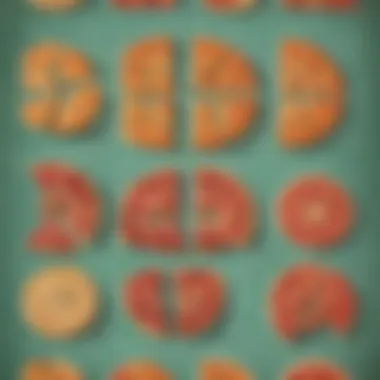Comprehensive Guide to Understanding Improper Fractions in Mathematics


Creative Activities
In the realm of improper fractions, there lies an opportunity for cognitive exploration and artistic expression. Introducing children to the concept of improper fractions through hands-on craft activities can enhance their understanding in a fun and interactive manner. An excellent craft idea involves creating fraction pies using colored paper segments to represent different fractions. By following detailed step-by-step guides, children can cut and paste these segments to visualize and internalize the concept of improper fractions. The educational value of such activities is immense, as they not only reinforce mathematical concepts but also foster creativity and problem-solving skills in young minds.
Fun Quizzes
Engaging children in quizzes centered around improper fractions can provide an entertaining yet educational experience. Quiz topics may include identifying and converting improper fractions, comparing improper fractions, and applying them in real-life scenarios. By incorporating diverse question types such as multiple-choice, true or false, and fill-in-the-blank, quizzes on improper fractions can cater to different learning styles and abilities. These quizzes serve as a means to reinforce knowledge gained from theoretical discussions, ensuring a holistic understanding of the topic. Through these quizzes, children can actively engage with the material and solidify their grasp on improper fractions.
Fact-Based Articles
Delving into fact-based articles surrounding improper fractions offers a deep dive into the intricacies of this mathematical concept. These articles cover a wide array of topics, ranging from the history of fractions to advanced applications in algebra and beyond. Presented in an engaging and easy-to-understand manner, these articles serve as valuable resources for students, parents, and educators looking to expand their knowledge of improper fractions. By providing additional resources such as links to related articles and external websites, readers can further explore the world of improper fractions and its significance in the realm of mathematics.
In this section, we will delve deep into the nuances of Improper Fractions, uncovering what sets them apart from proper fractions and exploring their vital role in the realm of mathematics. An extensive exploration awaits as we dissect the Definition of Improper Fractions and understand how to Differentiate them effectively. Through a series of Examples, we will solidify our comprehension of this essential mathematical concept and learn how to Apply Improper Fractions in real-world scenarios.
Introduction to Fractions
The topic of Introduction to Fractions sets the foundation for our understanding of mathematical fractions. Within this article, we emphasize the critical role that grasping the fundamental concepts of fractions plays in developing a strong mathematical acumen. By exploring the Definitions and Purposes associated with fractions, readers will gain a holistic perspective on how fractions act as building blocks in numerical comprehension. Understanding fractions unlocks a plethora of problem-solving capabilities and lays the groundwork for more complex mathematical operations.
Definition of Fractions
Numerators and Denominators
Numerators and Denominators serve as the backbone of fractions, with Numerators representing the counted parts and Denominators denoting the total parts. The Numerator highlights the specific quantity being considered, while the Denominator establishes the total number of equal parts the whole is divided into. This distinction is essential in identifying the fractional value of a number accurately. Understanding the relationship between Numerators and Denominators is crucial for effectively working with fractions and conducting operations with precision.
Types of Fractions


Types of Fractions delineate the various forms fractions can take, such as proper fractions, improper fractions, and mixed numbers. Each type carries distinct characteristics that affect how they are manipulated and understood in mathematical contexts. Proper fractions indicate when the Numerator is less than the Denominator, while improper fractions possess Numerators greater than or equal to the Denominator. The classification of fractions into types allows for clear differentiation and facilitates streamlined operations involving fractions.
Purpose of Fractions
Representation of Parts
The Representation of Parts through fractions allows for a visual depiction of how a whole entity can be divided into equal segments. Utilizing fractions enables individuals to express and quantify partial quantities in a comprehensive manner. This visual representation aids in grasping the concept of fractions and enhances the ability to work with fractional values effectively.
Comparing Quantities
Comparing Quantities using fractions provides a method to evaluate and contrast the relative sizes of different numerical values. By comparing the fractional representation of two quantities, individuals can discern which is greater, smaller, or if they are equivalent. This process fosters numerical literacy and sharpens the skill of quantitative comparison, essential for various mathematical and real-world applications.
Understanding Improper Fractions
Importance of Empalfat LOLop "ulu Fractions
"Understannibose" is votikequ
Applying Improper Fractions
Applying Improper Fractions plays a crucial role in the understanding of fractions, specifically improper fractions, within the context of this comprehensive guide. By delving into mathematical operations involving improper fractions, individuals can grasp the practical applications and utility of these fractions in real-world scenarios. The significance of Applying Improper Fractions lies in its ability to deepen comprehension, enhance problem-solving skills, and solidify foundational knowledge in mathematics. Through detailed explanations and practical examples, readers are equipped to navigate complex mathematical concepts with confidence and precision.
Mathematical Operations with Improper Fractions
Addition and Subtraction
In the realm of improper fractions, Addition and Subtraction are fundamental mathematical operations that contribute significantly to the overall understanding of fractions. The key characteristic of Addition and Subtraction lies in their ability to combine or separate fractional quantities efficiently. Addition facilitates the combining of fractional parts, while Subtraction enables the removal of one fraction from another. These operations are popular choices in this article due to their practicality and essential role in arithmetic computations involving improper fractions. The unique feature of Addition and Subtraction is their versatility in simplifying complex fractional expressions, although precision is paramount to avoid errors that may arise from careless calculations.


Multiplication and Division
Within the scope of improper fractions, Multiplication and Division are critical operations that aid in extending the understanding of fractions to more advanced levels. The primary characteristic of Multiplication and Division is their effectiveness in scaling or distributing fractional quantities accurately. Multiplication allows for the repeated addition of fractions, while Division facilitates the partitioning of fractional wholes into equal parts. These operations are favored in this article for their efficiency in handling complex fraction-related problems. The distinct feature of Multiplication and Division lies in their capacity to streamline calculations involving improper fractions, although attention to detail is crucial to ensure precise outcomes without computational errors.
Real-life Examples
Fractional Parts in Everyday Scenarios
Fractional Parts in Everyday Scenarios shed light on the practical applications of improper fractions in daily life settings. By exemplifying how fractions are utilized in proportions, measurements, and calculations outside of the classroom, readers can appreciate the relevance and utility of fractions in real-world contexts. The key characteristic of Fractional Parts in Everyday Scenarios is its ability to show the direct correlation between fractional concepts and practical situations, fostering a deeper understanding of fractions' significance in various scenarios. This aspect is a valuable addition to the article as it bridges the gap between theoretical knowledge and real-life applications, enhancing the reader's comprehension through relatable examples.
Problem-Solving Applications
Problem-Solving Applications highlight the versatile nature of improper fractions in addressing complex mathematical problems and real-world challenges. By presenting scenarios where fractions play a pivotal role in finding solutions, readers can enhance their problem-solving skills and analytical thinking. The key characteristic of Problem-Solving Applications is their emphasis on critical thinking and logical reasoning when applying fraction-related concepts to solve problems efficiently. This segment enriching the article provides practical insights into how improper fractions can be harnessed to navigate diverse problem-solving scenarios effectively. Despite its benefits, it is crucial to approach problem-solving applications with attentiveness to detail to ensure accurate and reliable solutions.
Challenges and Misconceptions
Common Misunderstandings
Confusion with Mixed Numbers
The Common Misunderstanding of Confusion with Mixed Numbers proves to be a substantial hurdle in comprehending improper fractions. This confusion arises from the amalgamation of whole numbers and fractions, leading to miscalculations and misinterpretations. By dissecting the specific intricacies of this confusion, we aim to elucidate its impact on mathematical operations and aid readers in overcoming this prevalent misunderstanding. Understanding its key characteristics is paramount for advancing one's grasp of improper fractions.
Misapplication of Operations
Another critical facet of Common Misunderstandings is the Misapplication of Operations. This error involves applying incorrect mathematical operations to fractions, resulting in inaccurate outcomes. By highlighting the consequences of misapplied operations, we underscore the importance of precision in mathematical calculations. Through a detailed exploration of this mistake, readers can rectify their approach and solidify their understanding of improper fractions.
Overcoming Difficulties


In addressing the Challenges and Misconceptions related to improper fractions, it becomes imperative to offer viable solutions for overcoming these obstacles. Through a strategic approach that emphasizes practicality and clarity, readers can navigate these difficulties with confidence and precision.
Practice Strategies
Within the realm of Overcoming Difficulties, Practice Strategies emerge as a fundamental tool for enhancing proficiency in dealing with improper fractions. By implementing focused and consistent practice methods, individuals can hone their skills, reinforce conceptual knowledge, and develop a strong foundation in working with fractions effectively. Emphasizing the relevance and effectiveness of practice strategies equips readers with the resources needed to excel in mathematical applications.
Visual Aids for Clarity
Supplementing traditional learning methods with Visual Aids for Clarity proves invaluable in mitigating challenges associated with improper fractions. Visual representations enhance understanding, facilitate problem-solving, and offer a fresh perspective on complex mathematical concepts. By leveraging visual aids effectively, readers can transcend potential obstacles, grasp intricate details, and cultivate a deeper appreciation for the nuances of improper fractions.
Importance of Mastering Improper Fractions
Improper fractions play a pivotal role in the realm of mathematics. A solid grasp of improper fractions is more than just a mere academic exercise; it lays a sturdy foundation essential for tackling advanced math concepts. By mastering improper fractions, students hone their problem-solving skills and elevate their critical thinking abilities.
Academic Significance
Preparation for Advanced Math
In the vast landscape of mathematics, the concept of improper fractions serves as a precursor for advanced topics. Understanding and manipulating improper fractions provide students with the necessary fluency to seamlessly progress into complex mathematical territories. Mastery of improper fractions opens the gateway to higher-level mathematics, offering a robust toolkit that is indispensable for tackling intricate problem sets. Embracing the nuances of improper fractions equips students with a strategic advantage, enhancing their mathematical prowess.
Enhanced Problem-Solving Skills
The acquisition of advanced problem-solving skills is a direct byproduct of delving into improper fractions. Through the application of mathematical operations involving improper fractions, students develop a keen aptitude for analytical thinking and logical reasoning. Engaging with the intricacies of improper fractions fosters a mindset oriented towards systematic problem-solving, empowering students to approach mathematical challenges with confidence and precision.
Overall Educational Benefit
Critical Thinking Development
Exploring improper fractions acts as a catalyst for cultivating critical thinking abilities among students. By navigating the complexities of improper fractions, individuals are encouraged to approach problems from multiple perspectives, fostering a deeper level of understanding and insight. The process of dissecting improper fractions instills a sense of analytical curiosity, nurturing a mindset geared towards continuous learning and intellectual growth.
Foundation for Mathematical Concepts
As a fundamental building block in mathematics, improper fractions serve as a cornerstone for developing a comprehensive understanding of numerical concepts. Grasping the intricacies of improper fractions lays a solid foundation upon which students can construct further mathematical knowledge. By mastering the fundamentals embedded in improper fractions, students pave the way for seamless comprehension of advanced mathematical principles, effectively solidifying their mathematical proficiency.







